Smoking Gentlemen—How Formula One Has Controlled CO2 Emissions
Abstract
1. Introduction
2. Review of Literature—CO2, Motorsports, and Formula One
2.1. Motorsports as a Source of CO2
2.2. Formula One as a Regular Source of CO2 Emissions
2.3. F1 Tanks, Fuel Consumption, and CO2 Emissions
3. Empirical Section
- (1)
- We studied the changes in F1 cars’ tanks capacity;
- (2)
- We then analyzed the changes in the number of cars finishing each Sunday’s race along the F1 seasons;
- (3)
- We then estimated the fuel consumption for each Sunday race;
- (4)
- Finally, based on the previous estimates, we estimated the level of CO2 emissions from F1 cars running in Sunday races.
3.1. Changes in Tank Capacity
3.2. Changes in the Number of Cars Finishing Races
3.3. Changes in Fuel Consumption
3.4. Changes in CO2 Emissions
4. Conclusions and Research Challenges
Acknowledgments
Conflicts of Interest
Appendix A
| Series | Mean | Standard Deviation | Minimum | Maximum | ADF | |||
|---|---|---|---|---|---|---|---|---|
| No Interception; No Trend | With Interception; No Trend | With Interception; With Trend | ||||||
| Tank capacity, median (Source: a, b, c) | 177.82 | 33.71 | 115 | 255 | d = 0 | −0.33 (1) | −2.73 *(1) | −2.86 (2) |
| d = 1 | −5.02 ***(2) | −4.98 ***(2) | −4.99 ***(2) | |||||
| Average # cars finishing each race (Source: d) | 14.64 | 4.00 | 7 | 23.21 | d = 0 | −0.264(2) | −3.24 **(1) | −3.57 **(2) |
| d = 1 | −8.15 ***(1) | −8.10 ***(1) | −8.02 ***(1) | |||||
| Consumed fuel (liters) (1950–2015) (Source: Monte-Carlo simulations upon Sources a, b, c, and d). | 2610.44 | 868.90 | 926.82 | 4774.87 | d = 0 | −0.47(1) | −2.77 *(1) | −2.78(1) |
| d = 1 | −7.75 ***(1) | −7.70 ***(1) | −7.65 ***(1) | |||||
| CO2, log (Kg) (1950–2015) (Source: Monte-Carlo simulations upon Sources a, b, c, d, and e) | 6043.44 | 2011.60 | 2145.68 | 11,054.32 | d = 0 | −0.47(1) | −2.77 *(1) | −2.78(2) |
| d = 1 | −7.75 ***(1) | −7.70 ***(1) | −7.65 ***(1) | |||||
References
- Fulton, L.; Mejia, A.; Arioli, M.; Dematera, K.; Lah, O. Climate Change Mitigation Pathways for Southeast Asia: CO2 Emissions Reduction Policies for the Energy and Transport Sectors. Sustainability 2017, 9, 1160. [Google Scholar] [CrossRef]
- Centobelli, P.; Cerchione, R.; Esposito, E. Developing the WH2 framework for environmental sustainability in logistics service providers: A taxonomy of green initiatives. J. Clean. Prod. 2017, 165, 1063–1077. [Google Scholar] [CrossRef]
- Tso, G.; Guan, J. A multilevel regression approach to understand effects of environment indicators and household features on residential energy consumption. Energy 2014, 66, 722–731. [Google Scholar] [CrossRef]
- Marquart-Pyatt, S. Contextual Influences on Environmental Concern Cross-Nationally: A Multilevel Investigation. Soc. Sci. Res. 2012, 41, 1085–1099. [Google Scholar] [CrossRef] [PubMed]
- Eurobarometer. First Results May 2008. Available online: http://ec.europa.eu/public_opinion/archives/eb/eb69/eb_69_first_en.pdf (accessed on 23 November 2017).
- Carvalho, M.; Bonifacio, M.; Dechamps, P. Building a low carbon society. Energy 2011, 36, 1842–1847. [Google Scholar] [CrossRef]
- Yearley, S. Bridging the science-policy divide in urban air-quality management: Evaluating ways to make models more robust through public engagement. Environ. Plan. C 2006, 24, 701. [Google Scholar] [CrossRef]
- Brechin, S.; Kempton, W. Beyond Postmaterialist Values: National versus Individual Explanations of Global Environmentalism. Soc. Sci. Q. 1997, 78, 16–20. [Google Scholar]
- Prescott-Clarke, P.; Mostyn, B. Public Attitudes towards Industrial, Work Related and Other Risks; Social and Community Planning Research: London, UK, 1982. [Google Scholar]
- Ahmad, N.; Du, L.; Lu, J.; Wang, J.; Li, H.; Hashmi, M. Modelling the CO2 emissions and economic growth in Croatia: Is there any environmental Kuznets curve? Energy 2017, 123, 164–172. [Google Scholar] [CrossRef]
- Steen, M. Greenhouse Gas Emissions from Fossil Fuel Fired Power Generation Systems; Joint Research Centre/European Comission: Brussels, Belgium, 2001. [Google Scholar]
- Olabi, A. 100% sustainable energy. Energy 2014, 77, 1–5. [Google Scholar] [CrossRef]
- Gillingham, K.; Newell, R.; Palmer, K. Energy Efficiency Economics and Policy. Annu. Rev. Resour. Econ. 2009, 1, 597–620. [Google Scholar] [CrossRef]
- Gallego, F.; Montero, J.; Salas, C. The effect of transport policies on car use: A bundling model with applications. Energy Econ. 2013, 40, 85S–97S. [Google Scholar] [CrossRef]
- EPA Sources of Greenhouse Gas Emissions. Available online: https://www.epa.gov/ghgemissions/sources-greenhouse-gas-emissions (accessed on 23 November 2017).
- OECD/IEA. CO2 Emissions from Fuel Combustion; OECD/International Energy Agency: Paris, France, 2016. [Google Scholar]
- Voltes-Dorta, A.; Perdiguero, J.; Jimenez, J. Are car manufacturers on the way to reduce CO2 emissions?: A DEA approach. Energy Econ. 2013, 38, 77–86. [Google Scholar] [CrossRef]
- Storchmann, K. Long-Run Gasoline demand for passenger cars: The role of income distribution. Energy Econ. 2005, 27, 25–58. [Google Scholar] [CrossRef]
- Falco, C.; Donzelli, F.; Olper, A. Climate Change, Agriculture and Migration: A Survey. Sustainability 2018, 10, 1405. [Google Scholar] [CrossRef]
- Nichols, A.; Maynard, V.; Goodman, B.; Richardson, J. Health, Climate Change and Sustainability: A systematic Review and Thematic Analysis of the Literature. Environ. Health Insights 2009, 3, 63–88. [Google Scholar] [CrossRef] [PubMed]
- Broto, V.; Bulkeley, H. A survey of urban climate change experiments in 100 cities. Glob. Environ. Chang. 2013, 23, 92–102. [Google Scholar] [CrossRef] [PubMed]
- Alnaser, W.; Probert, S.; El-Masri, S.; Al-Khalifa, S.; Flanagan, R.; Alnaser, N. Bahrain’s Formula-1 racing circuit: Energy and environmental considerations. Appl. Energy 2006, 83, 352–370. [Google Scholar] [CrossRef]
- Kravchenko, M.; Nosov, I. Motorsport and Sustainability: Case Study of MXStar Team’s Environmental Impact Optimization. Master’s Thesis, Uppsala Universitet, Uppsala, Sweden, 2011. [Google Scholar]
- Clerides, S.; Zachariadis, T. The effect of standards and fuel prices on automobile fuel economy: An international analysis. Energy Econ. 2008, 30, 2657–2672. [Google Scholar] [CrossRef]
- Allen, J. F1 Sponsors and Supporters Drive the Shift to Sustainability. Financial Times, 13 March 2014. [Google Scholar]
- Global Sports Impact Report 2016; Sportcal, Market Intelligence: London, UK, 2016.
- Coalter, F.; Taylor, J. Large Scale Sports Events: Event Impact Framework; Report to UK Sport; Department of Sports Studies, University of Stirling: Stirling, UK, 2008. [Google Scholar]
- Ornstein, D. Earth Car or not, Button will emit over 50 tonnes of CO2 this season. The Guardian, 2 March 2007. [Google Scholar]
- Ornstein, D. Formula 1 testing in Barcelona, day two as it happened. BBC Sport, 9 March 2011. [Google Scholar]
- Purcell, A. McLaren F1 team goes carbon neutral. New Scientist, 8 December 2011. [Google Scholar]
- TRUCOST. FOTA Environment Programme Baseline Report. Formula One Teams Association, Geneva. 2011. Available online: http://www.f1fanatic.co.uk/wp-content/uploads/2010/06/FOTA-Environment-Programme-Baseline-Report-2010.pdf (accessed on 23 November 2017).
- Galvin, R. How does speed affect the rebound effect in car travel? Conceptual issues explored in case study of 900 Formula 1 Grand Prix speed trials. Energy 2017, 128, 28–38. [Google Scholar] [CrossRef]
- Cimarosti, A. The Complete History of Grand Prix Motor Racing; Aurum Press: London, UK, 1997. [Google Scholar]
- Mack, J.; Schuler, D.; Butt, R.; Dibble, R. Experimental investigation of butanol isomer combustion in Homogeneous Charge Compression Ignition (HCCI) engines. Appl. Energy 2016, 165, 612–626. [Google Scholar] [CrossRef]
- Grez, M. Formula One Fuel’s Hidden 1%: The Best Kept Secret in Sport? Available online: http://edition.cnn.com/2015/07/24/motorsport/formula-one-fuel/ (accessed on 23 November 2017).
- Wright, P. Formula 1 Technology; Society of Automotive Engineers: Troy, MI, USA, 2001. [Google Scholar]
- Fagnan, R. F1 Technical: Fuel Tanks Explained. Available online: https://www.auto123.com/en/racing-news/f1-technical-fuel-tanks-explained?artid=109115&pg=2 (accessed on 23 November 2017).
- Edmondson, L. Is an F1 Car More Energy Efficient than an Electric Vehicle? Available online: http://www.espn.co.uk/f1/story/_/id/15152695/is-f1-car-more-energy-efficient-electric-vehicle (accessed on 23 November 2017).
- Taylor, L. Straw from Area Farmers Helps Fuel Ferrari’s F1 Dream Machines. Available online: http://www.iogen.ca/media-resources/iogen_news/2010_03_15_citizen.pdf (accessed on 23 November 2017).
- De Groote, S. Fuel. F1 Technical. Available online: http://www.f1technical.net/articles/19 (accessed on 23 November 2017).
- Flagan, R.C.; Seinfeld, J.H. Fundamentals of Air Pollution Engineering; Prentice-Hall Inc.: Upper Saddle River, NJ, USA, 1988; p. 542. [Google Scholar]
- Larsen, U.; Johansen, T.; Schramm, J. Ethanol as a Fuel for Road Transportation; IEA-AMF Report; 2009. [Google Scholar]
- Energy Information Administration. Carbon Dioxide Emissions Coefficients. 2016. Available online: https://www.eia.gov/environment/emissions/co2_vol_mass.cfm (accessed on 23 November 2017).
- Atlas F1. The 80s. 2000. Available online: http://atlasf1.autosport.com/evolution/1980s.html (accessed on 23 November 2017).
- Aue, J.; Horvath, L. Structural Breaks in Time Series. J. Time Ser. Anal. 2013, 34, 1–16. [Google Scholar] [CrossRef]
- Lu, S.; Ito, T. Structural Breaks and Time-varying Parameter: A Survey with Application. Commun. IBIMA 2008, 2008, 100037. [Google Scholar]
- Clemente, J.; Montañés, A.; Reyes, M. Testing for a unit root in variables with a double change in the mean. Econ. Lett. 1998, 59, 175–182. [Google Scholar] [CrossRef]
- Perron, P.; Vogelsang, T. Nonstationarity and level shifts with an application to purchasing power parity. J. Bus. Econ. Stat. 1992, 10, 301–320. [Google Scholar]
- Mourao, P.; Martinho, V. Discussing structural breaks in the Portuguese regulation on forestfires—An economic approach. Land Use Policy 2016, 54, 460–478. [Google Scholar] [CrossRef]
- Bai, J.; Perron, P. Critical values for multiple structural change tests. Econ. J. 2003, 6, 72–78. [Google Scholar] [CrossRef]
- Baum, C. Stata: The language of choice for time-series analysis? Stata J. 2015, 5, 46–63. [Google Scholar]
- Formula 1. Various Databases. Available online: http://www.formula1.com (accessed on 23 November 2017).
- Madier, D. The Formula 1 Hybrid Power Units 2014–2015. F1 Forecast. Available online: http://www.f1-forecast.com/pdf/The%20Formula%201%20Hybrid%20Power%20Units%202014-2015.pdf (accessed on 23 November 2017).
- Total Sportek2. How Much a Formula One Car Cost (Component Wise Price). Total Sportek2. 17 December 2014. Available online: http://www.totalsportek.com/f1/how-much-formula-1-car-cost-in-2015/ (accessed on 23 November 2017).
- Venkatesan How Much Fuel Is Consumed in One F1 Race. Available online: https://www.quora.com/How-much-fuel-is-consumed-in-one-F1-race (accessed on 23 November 2017).
- Arron, S. Crucial Brews. The Telegraph. 6 July 2002. Available online: http://www.telegraph.co.uk/motoring/4757155/Crucial-brews.html (accessed on 23 November 2017).
- Hynes, D. Formula One’s Eldest Statesman. AUTO Int. J. FIA 2014, 7, 66–68. [Google Scholar]
- Webcarstory. Various pages. Available online: http://www.webcarstory.com/?width=1152 (accessed on 23 November 2017).
- Wikipedia. Various pages. Available online: http://www.wikipedia.org (accessed on 23 November 2017).
- Formula 1. Various pages. Available online: https://www.formula1.com/ (accessed on 23 November 2017).
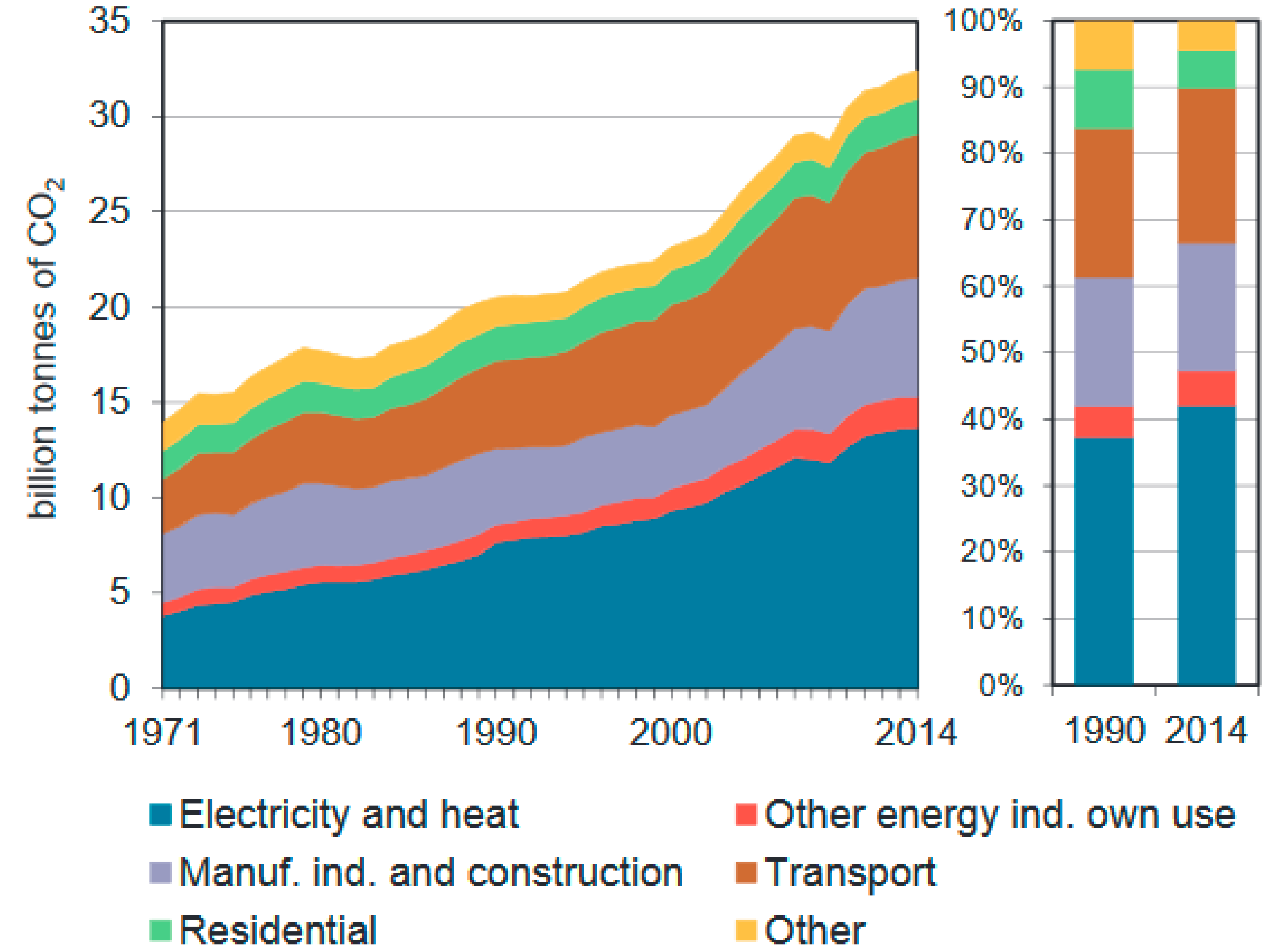
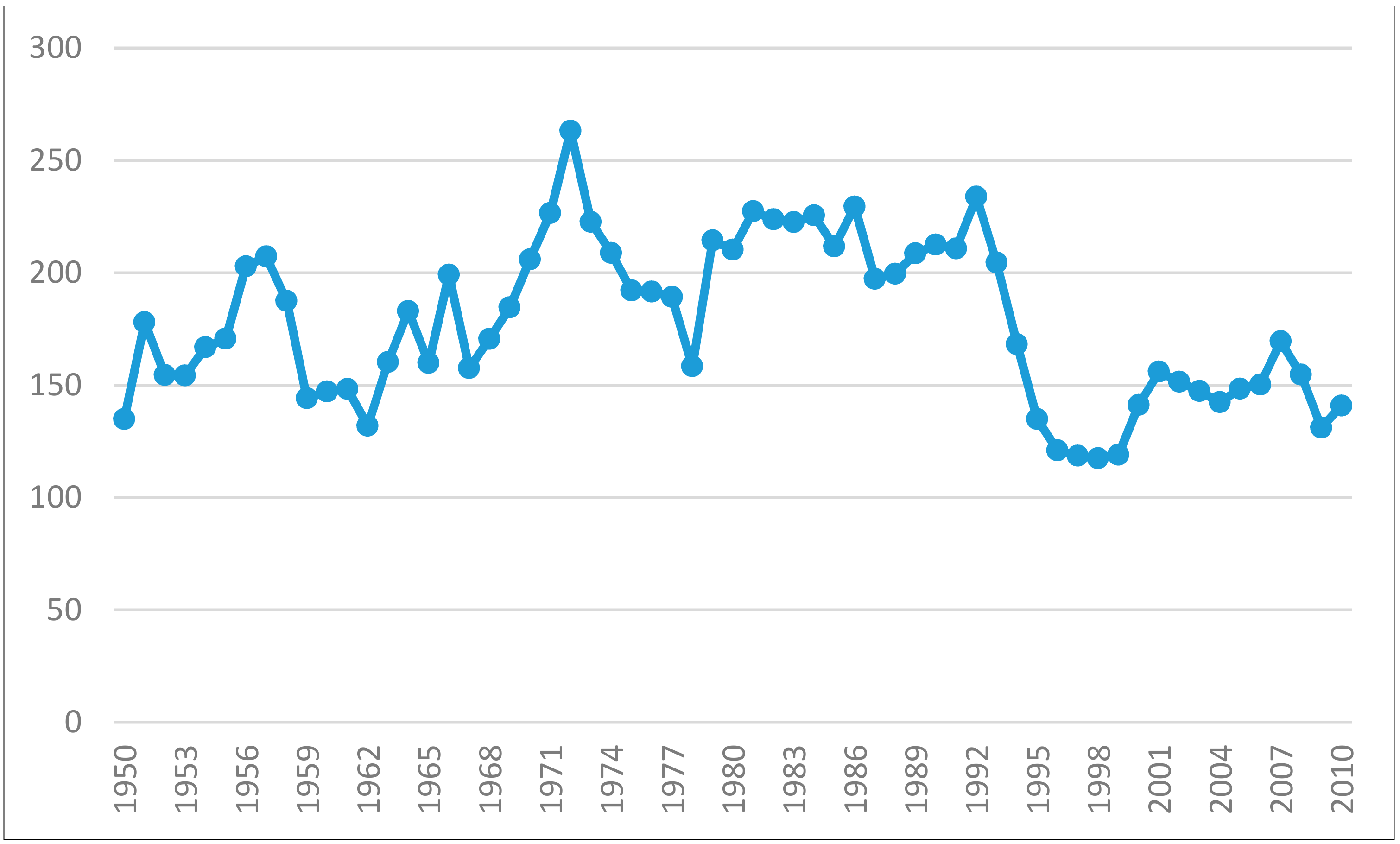
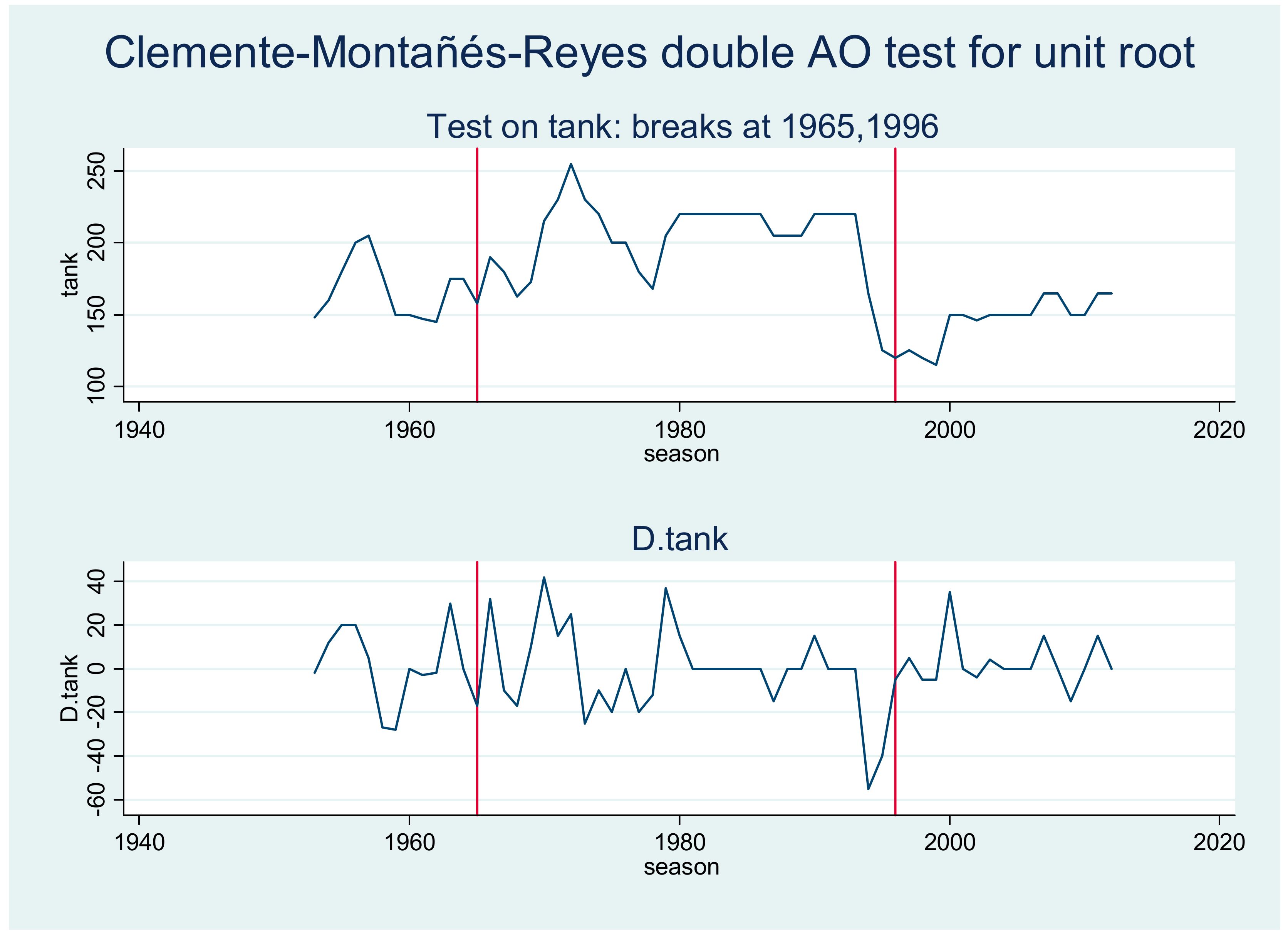
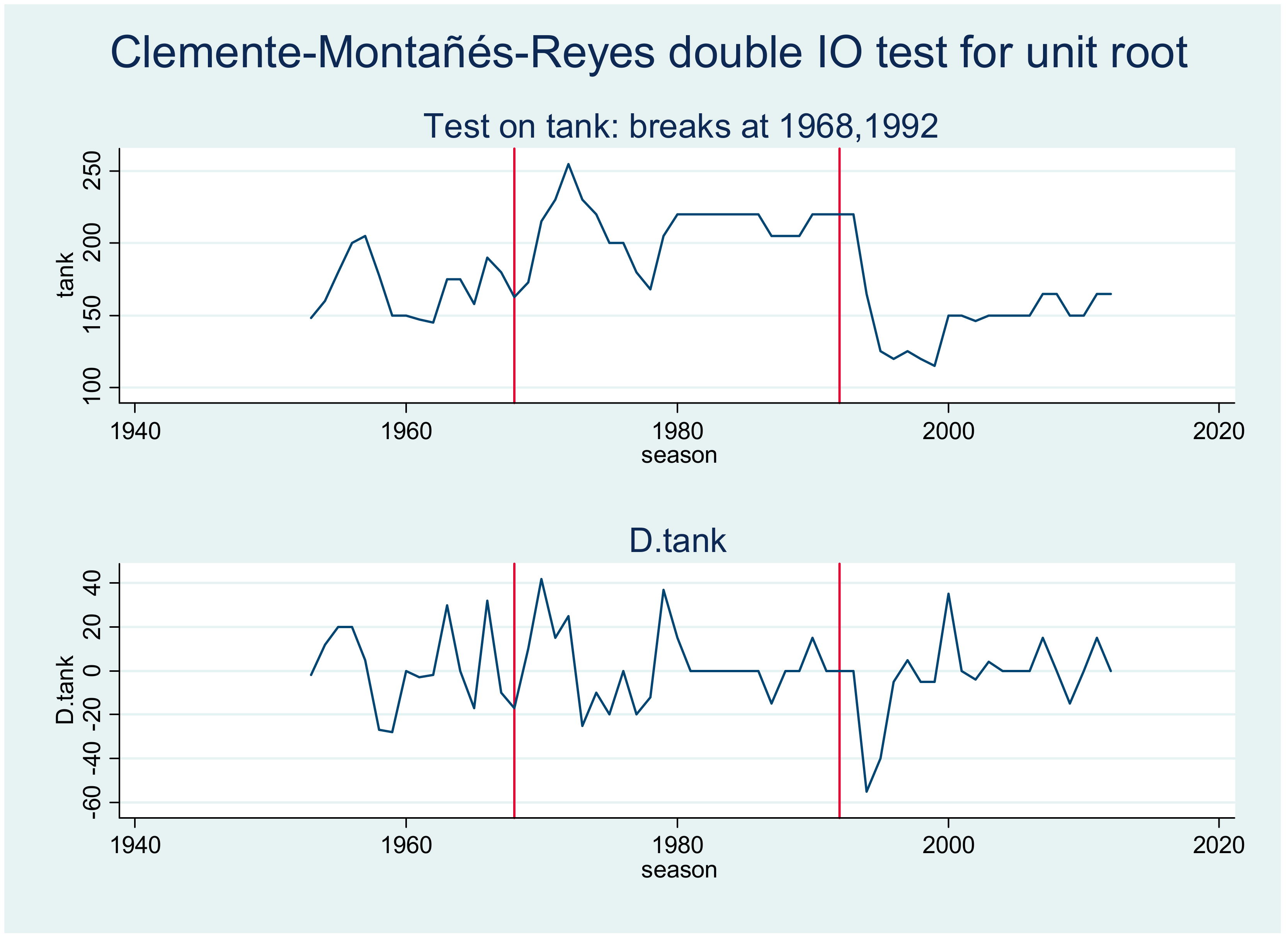
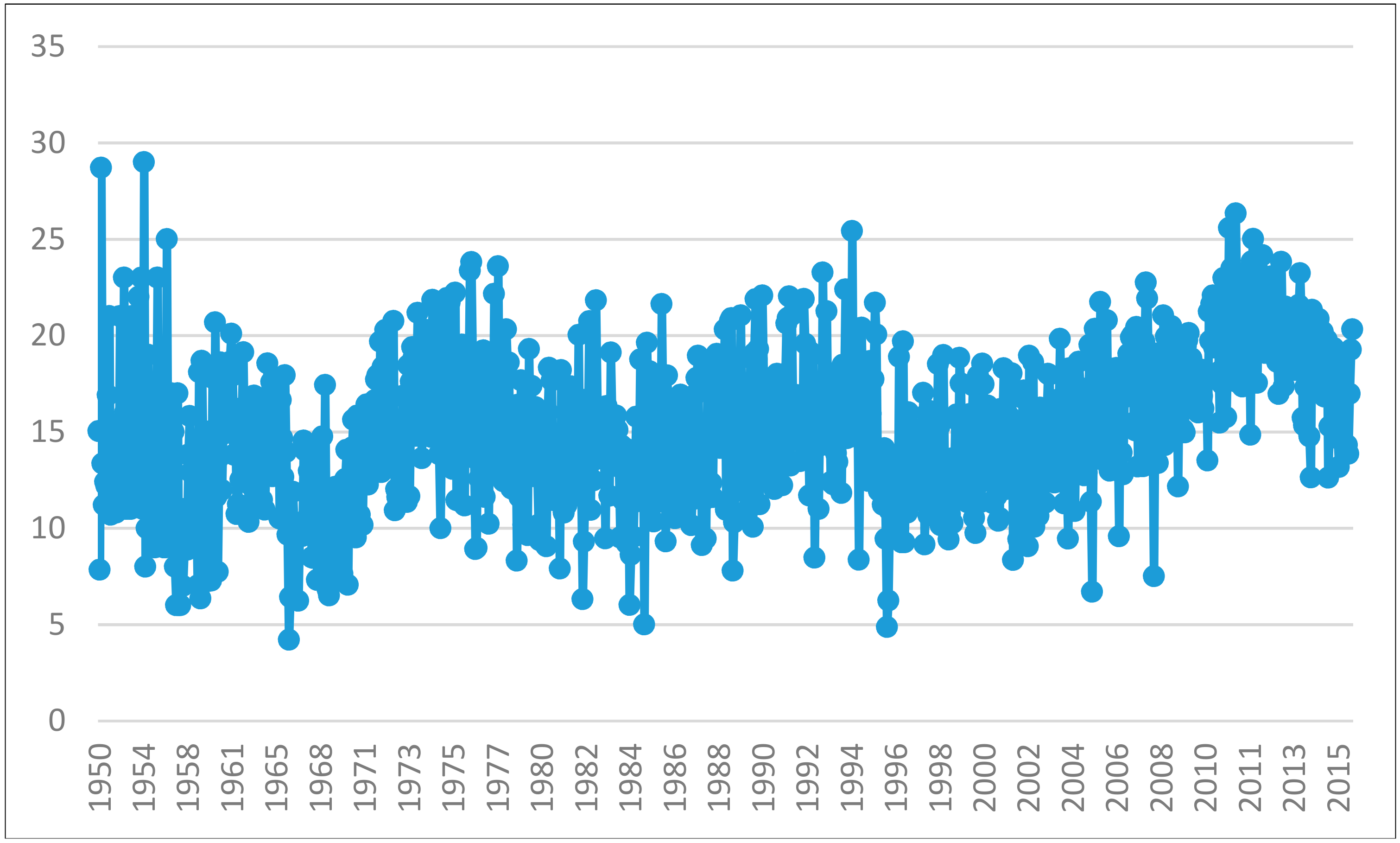
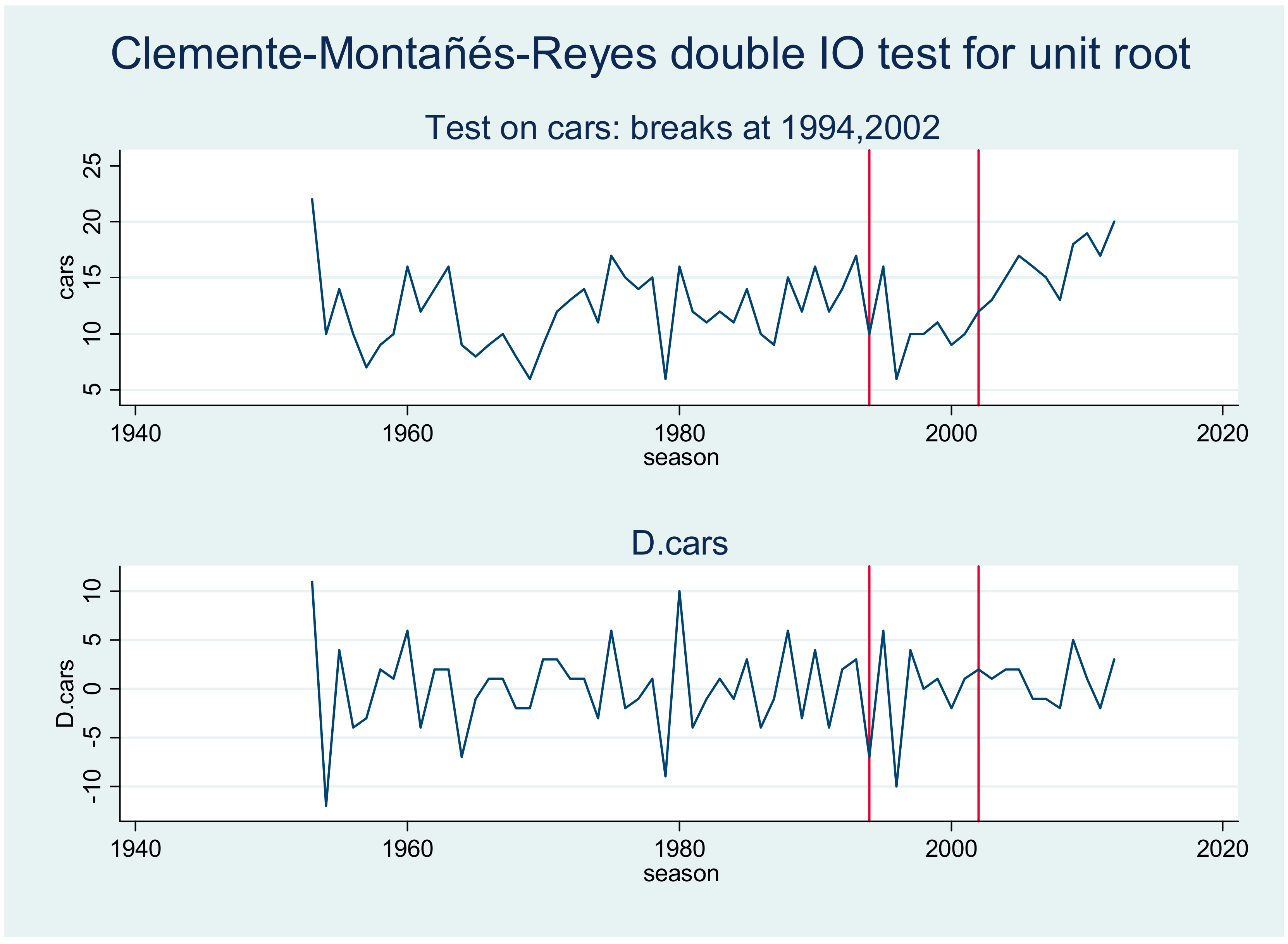

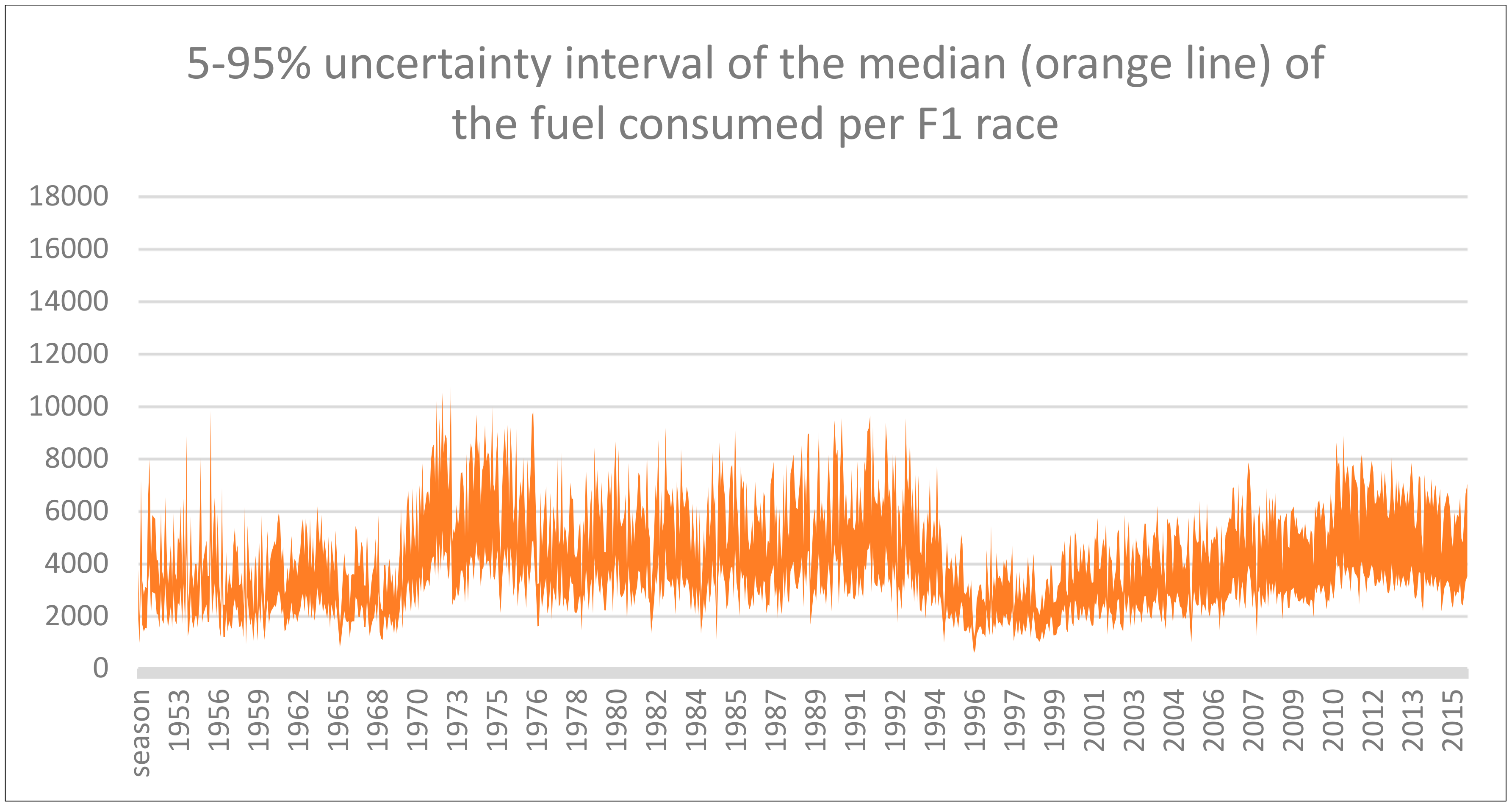
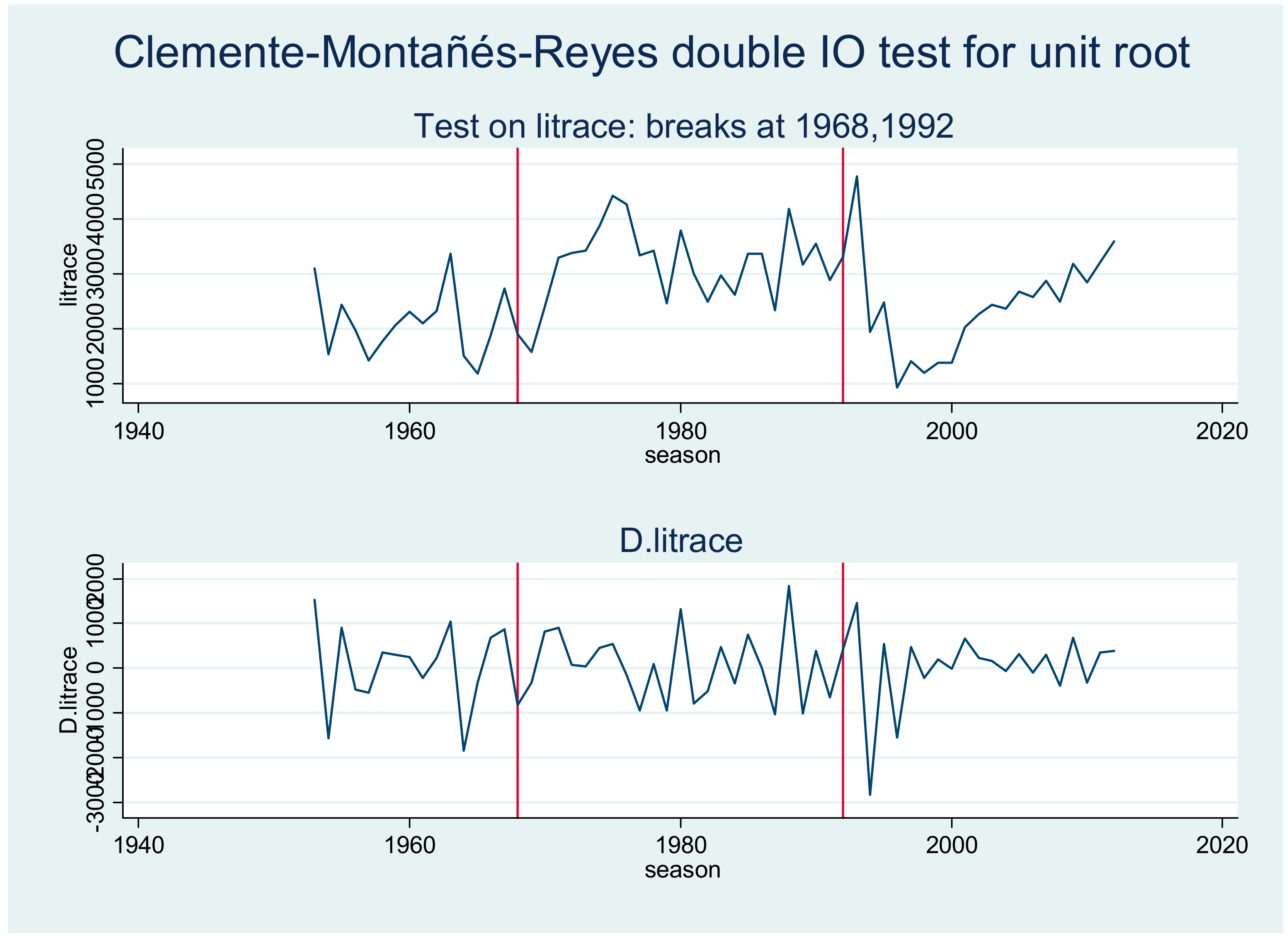
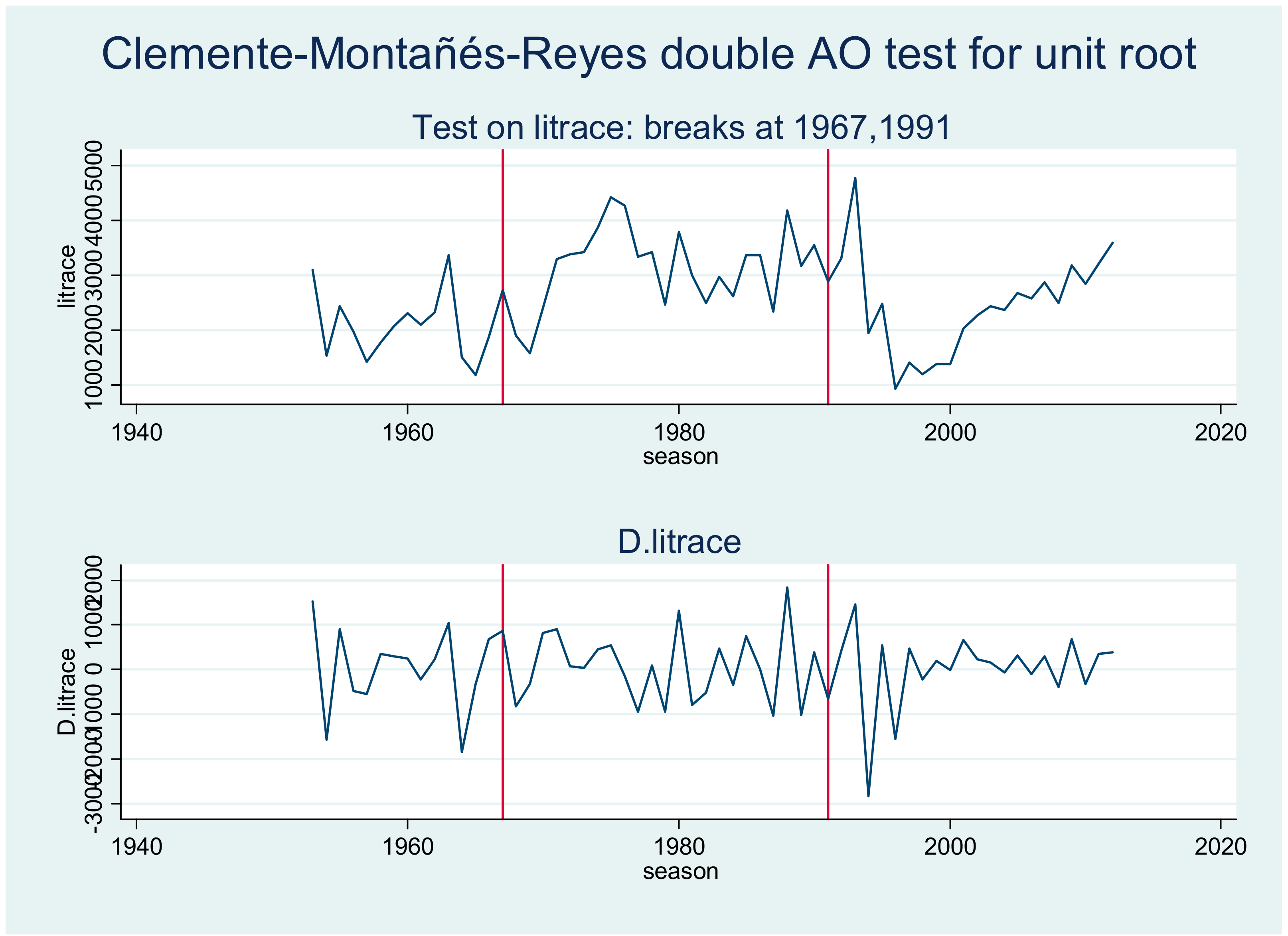
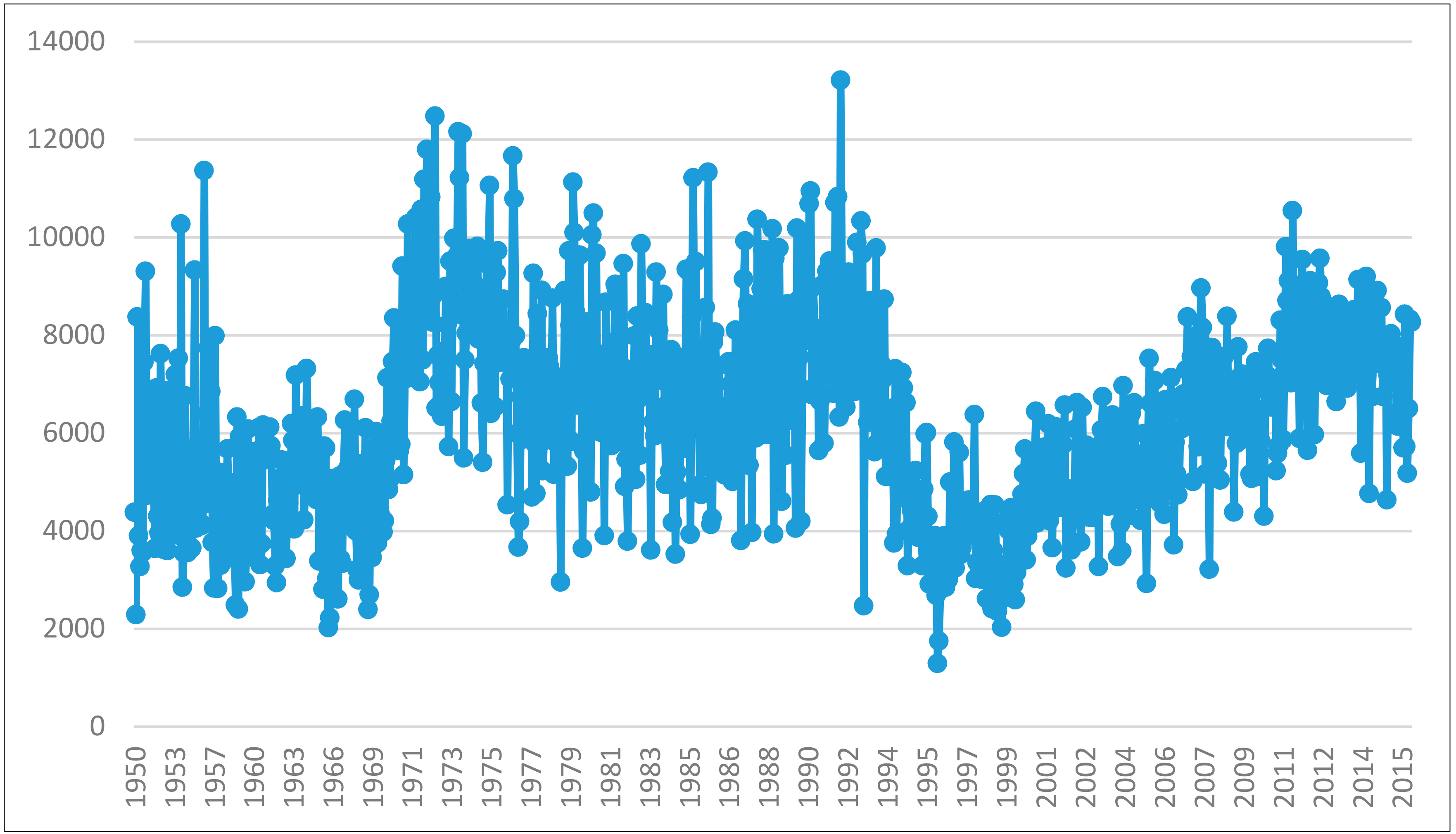
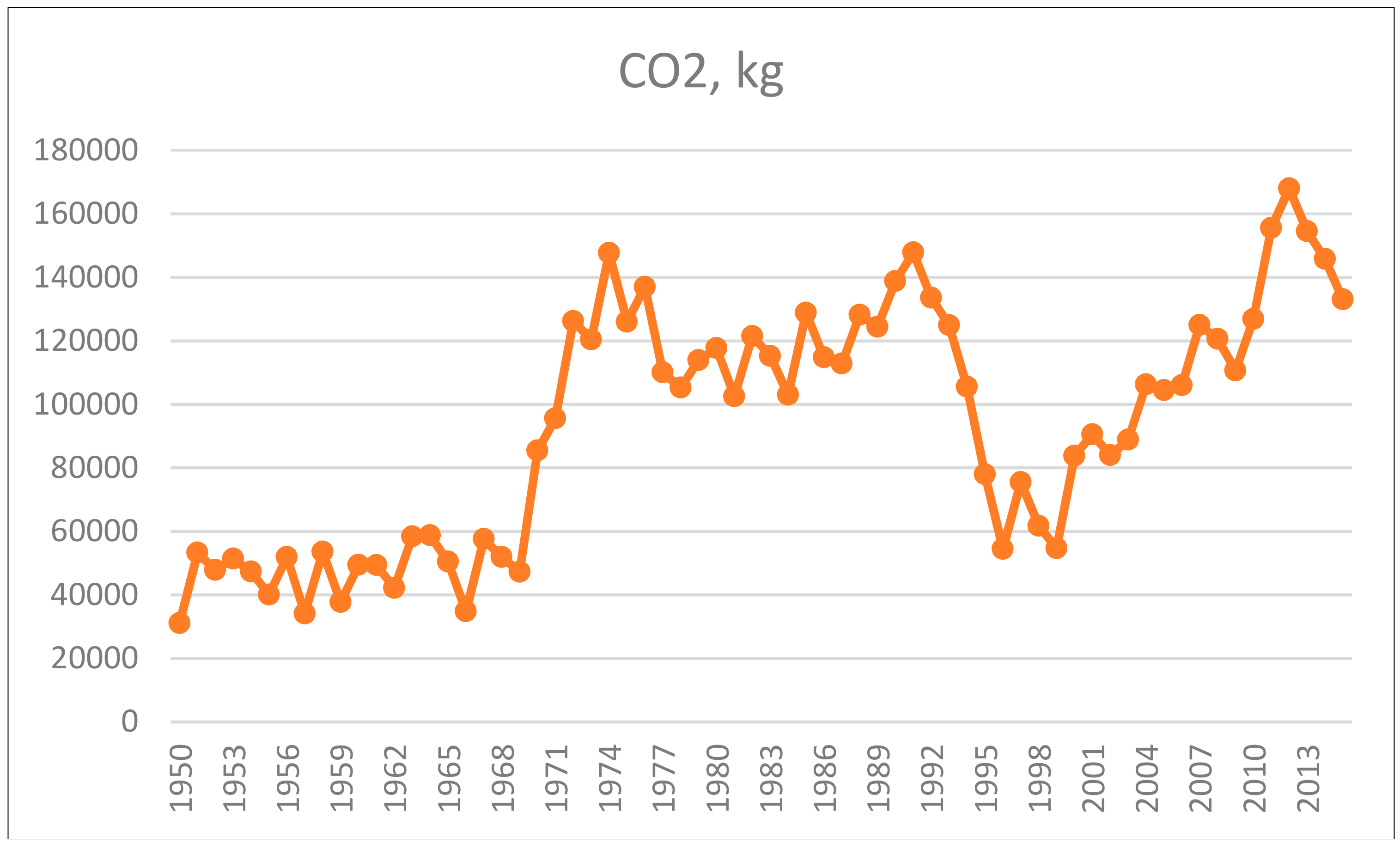
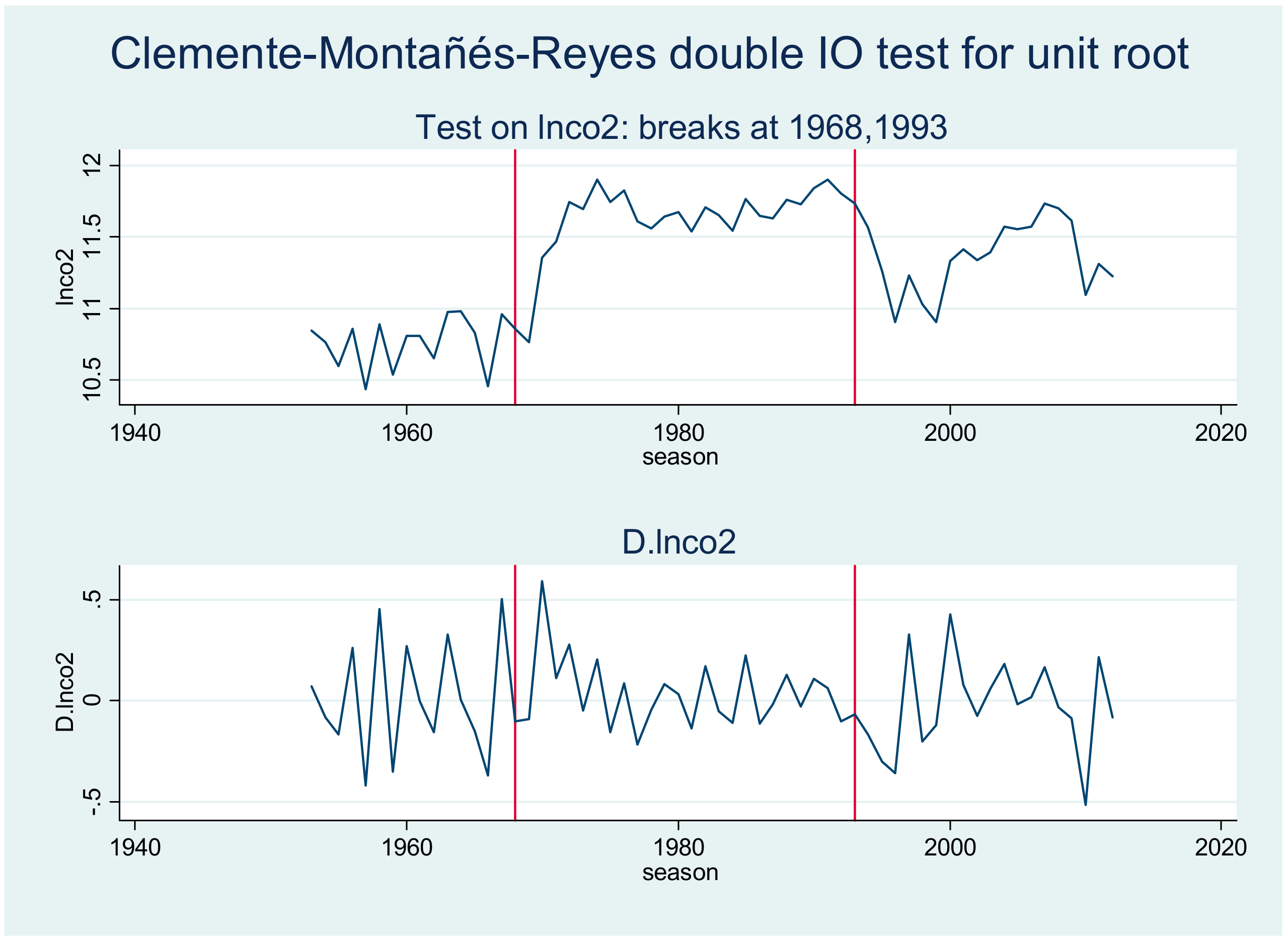
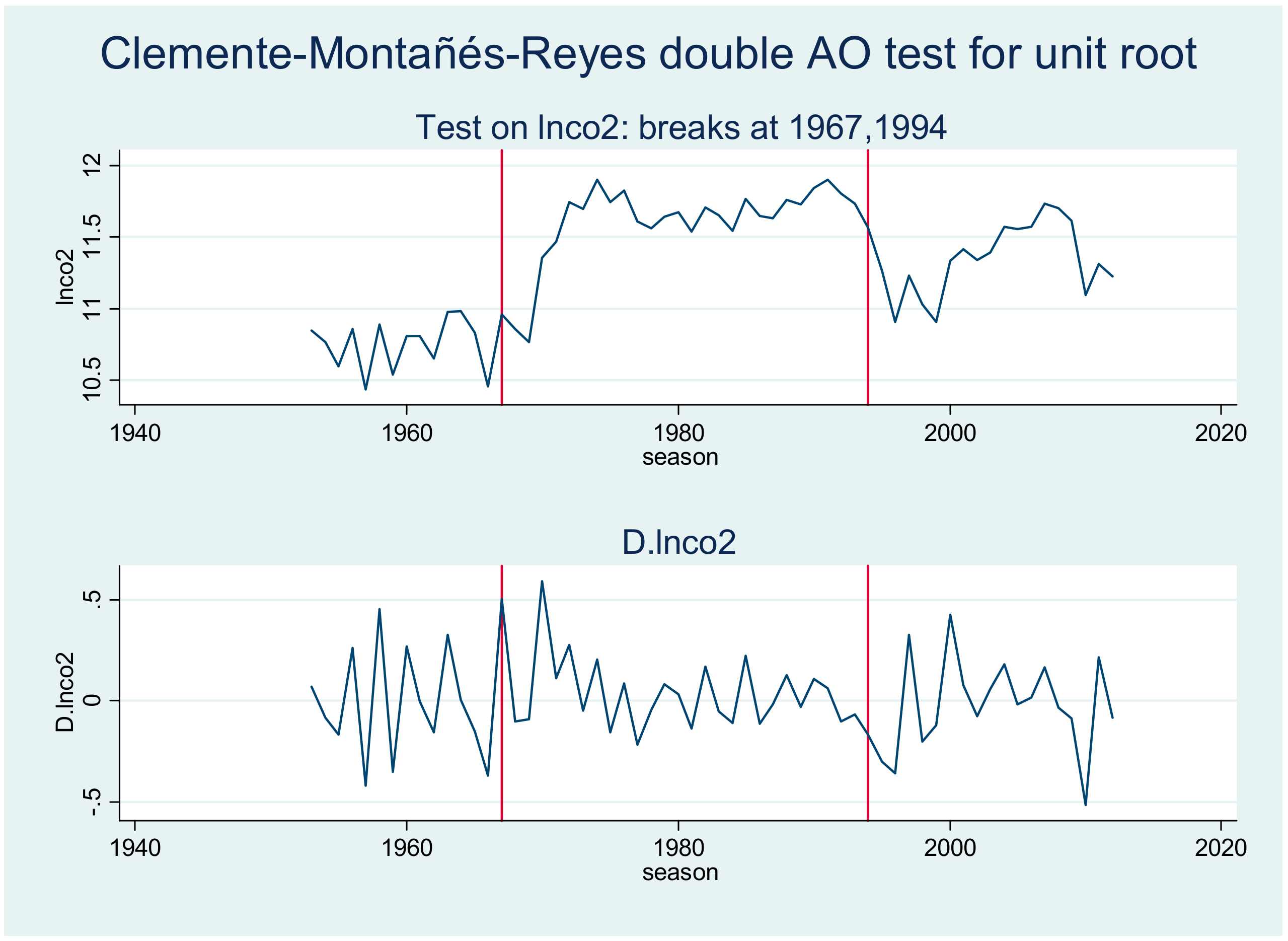
| Seasons | Tanks’ Capacity | Displacement/Power |
|---|---|---|
| 1950–1959 | Alfa Romeo 159/1951 (300 L) Lancia D50/1954 (205 L) Ferrari 801/1958 (200 L) | Alfa Romeo 159/1951 (1479 cc, 425 hp@9300 rpm). Lancia D50/1954 (2489 cc, 260 hp@8200 rpm). Ferrari 801/1958 (2486 cc, 285 hp@8800 rpm). |
| 1960–1969 | Cooper T51/1960 (150 L) Ferrari 312/1966 (158 L) BRM P138/1968 (173 L) | Cooper T51/1960 (2462 cc, 236 hp@6750 rpm) Ferrari 312/1966 (2989 cc, 390 hp@10,000 rpm) BRM P138/1968 (2998 cc, 390 hp@9500 rpm) |
| 1970–1979 | March 711/1971 (272 L) Ferrari 312T/1975 (200 L) Renault RS01T/1977 (200 L) | March 711/1971 (2993 cc, 480 hp@10,600 rpm) Ferrari 312T/1975 (2991 cc, 495 hp@12,200 rpm) Renault RS01T/1977 (1492 cc, 530 hp@10,000 rpm) |
| 1980–1989 | ATS D7/1984 (220 L) Williams FW10/1985 (220 L) McLaren MP4/1987 (197 L) | ATS D7/1984 (1500 cc, 850 hp@10,500 rpm) Williams FW10/1985 (1500 cc, 800 hp@11,000 rpm) McLaren MP4/1987 (1496 cc, 850 hp@12,000 rpm) |
| 1990–1999 | Williams FW14/1991 (220 L) Tyrrell 024/1996 (120 L) Benetton B198/1998 (125 L) | Williams FW14/1991 (3493 cc, 700 hp@12,500 rpm) Tyrrell 024/1996 (3000 cc, 690 hp@13,800 rpm) Benetton B198/1998 (3000 cc, 750 hp@14,000 rpm) |
| 2000–2009 | Sauber C22/2003 (146 L) Renault RS23/2003 (150 L) Honda RA106/2006 (150 L) | Sauber C22/2003 (2997 cc, 855 hp@18,600 rpm) Renault RS23/2003 (3000 cc, 800 hp@18,000 rpm) Honda RA106/2006 (2398 cc, 650 hp@19,500 rpm) |
| 2010–2015 | Ferrari 150/2011 (220 L) Ferrari F14/2014 (140 L) | Ferrari 150/2011 (2398 cc, 785 hp@18,000 rpm) Ferrari F14/2014 (1600 cc, 670 hp@15,000 rpm) |
| Series | Break Assumption | Optimal Breakpoints | t-Statistic (AR-n) |
|---|---|---|---|
| Tank capacity (liters) (1950–2015) | Additive Outliers | 1965 1996 | 4.961 *** (AR-1) −7.069 *** (AR-1) |
| Innovational Outliers | 1968 1992 | 5.751 *** (AR-3) −7.070 *** (AR-3) |
| Series | Break Assumption | Optimal Breakpoints | t-Statistic (AR-n) |
|---|---|---|---|
| # cars (1950–2015) | Additive Outliers | 1967 2006 | 0.582 (AR-1) 3.626 *** (AR-1) |
| Innovational Outliers | − | −1.703 * (AR-0)4.070 *** (AR-0) |
| Series | Break Assumption | Optimal Breakpoints | t-Statistic (AR-n) |
|---|---|---|---|
| Consumed fuel (liters) (1950–2015) | Additive Outliers | 1967 1991 | 4.651 *** (AR-4) −2.921 *** (AR-4) |
| Innovational Outliers | 1968 1992 | 3.793 *** (AR-5) −3.432 *** (AR-5) |
| Series | Break Assumption | Optimal Breakpoints | t-Statistic (AR-n) |
|---|---|---|---|
| CO2, log (Kg) (1950–2015) | Additive Outliers | 1967 1994 | 11.878 *** (AR-12) −4.242 *** (AR-12) |
| Innovational Outliers | 1968 1993 | 6.064 *** (AR-9) −4.568 *** (AR-9) |
© 2018 by the author. Licensee MDPI, Basel, Switzerland. This article is an open access article distributed under the terms and conditions of the Creative Commons Attribution (CC BY) license (http://creativecommons.org/licenses/by/4.0/).
Share and Cite
Mourao, P.R. Smoking Gentlemen—How Formula One Has Controlled CO2 Emissions. Sustainability 2018, 10, 1841. https://doi.org/10.3390/su10061841
Mourao PR. Smoking Gentlemen—How Formula One Has Controlled CO2 Emissions. Sustainability. 2018; 10(6):1841. https://doi.org/10.3390/su10061841
Chicago/Turabian StyleMourao, Paulo Reis. 2018. "Smoking Gentlemen—How Formula One Has Controlled CO2 Emissions" Sustainability 10, no. 6: 1841. https://doi.org/10.3390/su10061841
APA StyleMourao, P. R. (2018). Smoking Gentlemen—How Formula One Has Controlled CO2 Emissions. Sustainability, 10(6), 1841. https://doi.org/10.3390/su10061841





